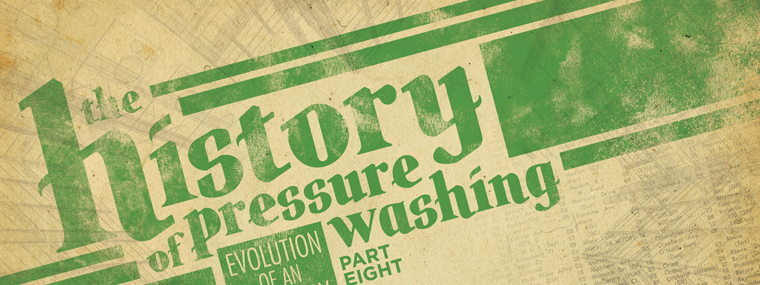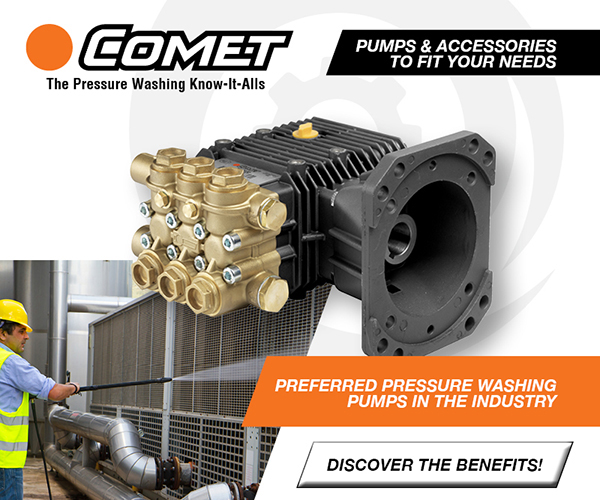
The History of Pressure Washing: Evolution of an Industry, Part Eight: Industry Collaboration: Strength in Numbers
By Terri Perrin / Published October 2014

Editor’s Note: This is the eighth in a multi-part series that traces the history of the pressure washing industry from the mid-1970s to present day. An 18-part history series, that covered the early history, was first published in Cleaner Times|IWA beginning in February 1996 and reprinted beginning in March 2007. Those interested in reading the early industry history, or who may have missed the first installments of this new series, may view them online at http://cleanertimes.com/artgrp.cfm?fpid=82.
By the early 1980s, networking and education at conventions and trade shows was becoming an important part of doing business for many industry sectors. Pressure washing was no exception.
After more than five decades of growth, manufacturers, distributors, and contractors in the pressure washing industry recognized that there would be advantages to working collaboratively. The old saying—there is strength in numbers—was proving to be true when it came to addressing ever-changing government regulations relating to safety and the environment.
Tim Layden, High PSI, Chicago, explains that distributors and manufacturers across the U.S.A. recognized that, as individual entities, they had little power and no financial resources to facilitate change. Collaboration would be crucial moving forward to ensure a high level of professionalism and to be certain that government regulators would hear the collective “voice of our industry.”
“Creating and supporting trade associations gave us the combined strength and financial resources to become more powerful as an industry,” explains Layden. “It enabled us to establish guidelines that made proper cleaning techniques and safety protocols mandatory, and it gave us a strong voice relating to many areas of government-regulated environmental best practices. Without this collaboration, the pressure washing industry would not have evolved as quickly.”
Next month, Cleaner Times|IWA will provide a history on three of the organizations that have been particularly instrumental in shaping the pressure washing and waterjetting industries:
• Cleaning Equipment Trade Association (CETA),
• Power Washers of North America (PWNA), and
• WaterJet Technology Association—Industrial & Municipal Cleaning Association (WJTA—IMCA).
Each of these volunteer-run organizations and several others have worked hard to develop and deliver educational and certification programs and events that have helped the industry as a whole.
“The relationships and connections we have through our CETA membership, for example, have been a tremendous asset to us,” explains Dennis Black, McHenry Pressure Cleaning Systems, Frederick, MD. “There are times when a customer may be outside of our geographical region, and it would not make economic sense for us to attempt to provide equipment repair services. In these cases, we can feel confident referring them to fellow CETA members. We all work together to help each other out by forming smaller sub-groups, like a peer group. We hold teleconferences several times a year to do some brainstorming and share insight on new markets. This kind of collaboration would not have happened prior to the formation of our trade associations. People were much more regional and local before having the opportunity to connect at annual conventions and trade shows.”
History of Pressure Washing
Upcoming Topics
• Industry Collaboration: Formation of Professional Associations, Part II
• Expanding Markets and Business Sectors: Internet and Social Media
• Changing Faces: A ‘New’ Breed of Owners and Staff
An example of how collaborative efforts of an organization result in positive change for the pressure washing industry as a whole is a recent achievement by CETA’s Technical Committee. The classification for certain types of pressure washing equipment changed on May 3, 2013. This change was the 18th amendment of Rule 219, drafted by the Governing Board of the South Coast Air Quality Management District (SCAQMD). CETA was able to lobby effectively on behalf of our industry, to ensure that these new regulations made sense. Government representatives were more open to hearing what a trade association had to say on the topic, rather than hearing from a handful of individuals. Dr. Marlo Dean was instrumental in getting these regulations approved.
Having started his career in 1971, John Purswell, Alklean Industries, Pasadena, TX, is no stranger to the pressure washing industry and its related associations. He has served three terms on the CETA Board of Directors, one year as President. He agrees that the formation of various associations was instrumental in driving industry change through the 1980s and ‘90s, but adds that the need for collaboration often stemmed from things that were beyond our control.
“Some of the changes were good for business, from a distributor’s point of view, and some of them were not so good,” says Purswell. “We learned some new words that we did not ever want to hear during this time. Alternative channels of distribution, for example, dramatically affected the lower end of the pressure washer market. I am referring to when the light commercial and consumer customers were almost entirely taken from the distributor and redirected through big box stores and catalogues. The effects of this new distribution model were a hot topic at all the early association meetings. In fact, I believe that many distributors showed up to their first few association meetings hoping to find an answer to that problem.
“This reminds me of a quote—I don’t remember the author—but it says, ‘there are no unanswered prayers, but sometimes the answer is no!’” adds Purswell. “That is essentially what happened to the distributors, when we went looking for answers of how to survive when we saw about half of our market disappear in 12 months. We can debate the pluses and minuses into eternity, but it is now part of history.
“Another nasty surprise came along during the ‘80s, when the selective enforcement of environmental laws began,” continues Purswell. “In my particular territory, in the Houston area, I estimate that only about five percent of our customers are allowed to wash and not capture the wash water runoff, get a permit from a public-owned treatment works, or treat and reuse it. The Associated Pressure Washer Distrib-utors (APD) was created as a result of these restrictions to offer a forum to reach distributors for education and marketing opportunities for water reclamation manufacturers. The Cleaning Equipment Manufacturers Association (CEMA) was addressing the safety issues, lack of safety standards, and other common interests. In 1990, the two organizations combined to form the Cleaning Equipment Trade Association (CETA). Since that historic beginning, many good things have come from CETA, but the most noticeable is the set of safety standards that finally have gained a lot of traction in our industry.
“I personally believe that the equipment that we sell today is much safer than the equipment of the ‘80s due, in part, to the hard work and volunteer efforts of those who serve on various boards of directors and committees of our industry associations. Virtually all distributors, manufacturers, and suppliers in this industry have benefitted enormously from trade associations born in the ‘80s. Even if they are not members, a rising tide floats all boats and, for sure, the pressure washing industry is better because of the developments from some of the dedicated members of CETA, and before them APD and CEMA, to name a few.
“I am just a plain-spoken, old country boy, so I want to say, ‘if you are riding the wagon, you should be feeding the mules,’” concludes Purswell. “If you are in the pressure washing industry, you are receiving benefits from the dedication of the volunteers who serve the industry through these associations. If you don’t serve directly, become a member and contribute through your membership dues.”
Next Month: We will continue our examination of industry collaboration and the formation of professional associations. Do you have any pressure washing stories, memories, or photos from 1980 through 2014 that you would like to share with Cleaner Times|IWA readers? Please e-mail terriperrinwriter@gmail.com to learn how you could be a part of this series.





